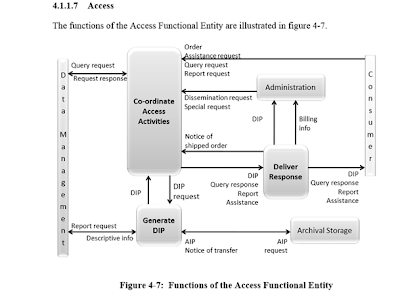The following is a compilation of a few definitions or examples of Light, Dark and Dim archives to better understand what they are.
The notion of "dark archives", supporting little or no access to archived materials, has met with scant enthusiasm in the library community. This suggests that digital repositories will function not just as guarantors of the long-term viability of materials in their custody, but also as access gateways. Lavoie
A secure digital repository sometimes referred to as a "dark archive" Kirsch
Dark
Archive: An archive that does not grant public access and only preserves the
information it contains. This can refer to a digital archive or repository as
well as brick & mortar archive. Michigan
Dark
archive: The purpose of a dark archive is to function as a repository for
information that can be used as a failsafe during disaster recovery. UCPress
The
Dark Archive is a secret place for storing archival material with restricted
user access. Tufts
We
chose to create a “dark” archive to focus our efforts on securing and
preserving large volumes of content important to libraries and their users;
however, it is not exclusively dark. Participating libraries experience the
archive as a “light” or accessible archive in two ways: auditing the archive to
ensure we are prepared to support eventual use and accessing of content that
has been made available as the result of a “trigger event” or post-cancellation
access claim. Portico
Dark
archives are certainly misunderstood both inside and outside the industry. So, what is a dark archive? It is, simply put, an archive of information
that is not used for public access. Most
often it serves as a failsafe copy of a light archive, i.e. a publicly
available version of the information, for use in disaster recovery
operations. Dark archives need not be a
fully operational copy of an information system, rather just the content behind
the information system. This is an
important distinction because maintaining an exact operational copy of an
information system is a much more complex and expensive undertaking than
maintaining only the content the information system operates on. Metaphorically, at its base definition, a
dark archive will require more than a flip of the switch to make a light
archive. Osti Bog
Dark
Archive: An archive that is inaccessible to the public. It is typically used
for the preservation of content that is accessible elsewhere. See also dim
archive, light archive.
Dim
Archive: An archive that is inaccessible to the public, but that can easily be
made accessible if required. It's typically used for the preservation of
content that is accessible elsewhere. See also dark archive, light archive.
Light Archive: An archive that is accessible to the public. See also dim archive and dark archive. CDL
A
DDP network may be an open archive, or it may reside somewhere on the spectrum
from dim to dark archive. That is, it may be open to only the contributors’
servers for ingesting (dark archive); it may be open to specified users, such
as the contributing institutions’ communities (dim archive); or it may provide unrestricted
access (open archive). This status will determine whether contributors will
focus solely on long-term preservation issues, or some combination of
preservation and public access issues. MetaArchive
Dark
Archive: Digital archive for which access to content is limited to
organizational custodians.
Dim Archive: Digital archive that incorporates elements of
both the Dark and Open Archive models. Access for some materials is restricted
to organizational custodians, while access for others may be open to a broad
user community.
Open Archive: A
digital archive that is publicly accessible. MetaArchive
Below are two figures from the OAIS Model (2012) showing the Access functions.


2 comments:
An interesting summary of definitions, thanks! I note you include diagrams from the OAIS model at the end. Would you consider a dark archive to basically be an implementation of this model without the "Access" box?
Post a Comment